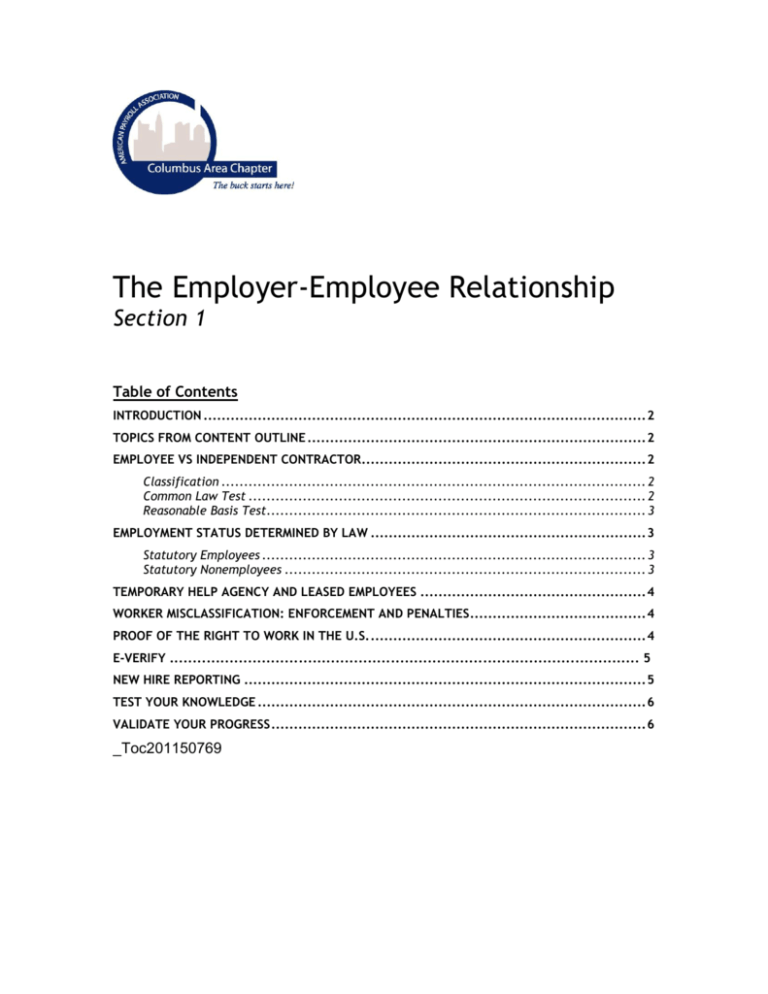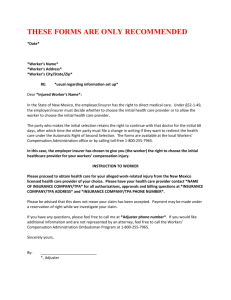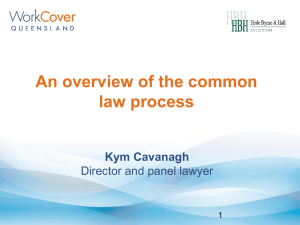2015 CPP Study Group Section 1 - Columbus Area Chapter APA
advertisement

The Employer-Employee Relationship Section 1 Table of Contents INTRODUCTION .................................................................................................. 2 TOPICS FROM CONTENT OUTLINE ........................................................................... 2 EMPLOYEE VS INDEPENDENT CONTRACTOR ............................................................... 2 Classification .............................................................................................. 2 Common Law Test ........................................................................................ 2 Reasonable Basis Test.................................................................................... 3 EMPLOYMENT STATUS DETERMINED BY LAW ............................................................. 3 Statutory Employees ..................................................................................... 3 Statutory Nonemployees ................................................................................ 3 TEMPORARY HELP AGENCY AND LEASED EMPLOYEES .................................................. 4 WORKER MISCLASSIFICATION: ENFORCEMENT AND PENALTIES ....................................... 4 PROOF OF THE RIGHT TO WORK IN THE U.S. ............................................................. 4 E-VERIFY ...................................................................................................... 5 NEW HIRE REPORTING ......................................................................................... 5 TEST YOUR KNOWLEDGE ...................................................................................... 6 VALIDATE YOUR PROGRESS ................................................................................... 6 _Toc201150769 1: The Employer-Employee Relationship Introduction Welcome to Section 1 of the CPP study group. Section 1—The Employer-Employee Relationship—covers content that is critical to build the foundation for becoming certified. The basis of payroll is about paying employees, so the first critical piece you need to learn, is what criteria an individual must meet to be classified as an employee. How are employees classified? What are the errors of misclassification? How do we know individuals are authorized to work? By the time you’re done with this chapter, you should be able to answer those questions. Throughout this document you’ll be given highlighted content to supplement The Payroll Source. While this content will not cover everything you need for the exam, it is a good tool to help facilitate studying. Topics from Content Outline Core Payroll Concepts Worker Status Employee vs Independent Contractor Classification Classifying an individual as an employee or independent contractor is critical for an individual, a company and the government agencies. Employers typically classify an individual as an independent contractor instead of employee. Why? 1 Independent contractors are given Form ______ 2 as a report of payments received as long as those payments reach $_______? 3 Common Law Test Relied upon by the IRS to make worker status determinations Right to control is the key 1. Behavioral control a. Level of instructions the business gives the worker b. Level of training provided to the worker 2. Financial control a. Whether the worker has unreimbursed business expenses b. Whether the worker has a substantial investment in the work c. Whether the worker’s services are available to the public d. How the worker is paid Fred is an experienced plumber who agreed to perform full-time services for ABC Corp. He uses his own tools and performs the work in the order designated by ABC. ABC supplies all of Fred’s materials, frequently inspects his work, pays him on a piecework basis and carries worker’s compensation insurance on him. Is Fred an employee or independent contractor? 4 Information contained herein is exclusive property of the Columbus Area Chapter Use of material is to be used by study group members only Page 2 of 7 1: The Employer-Employee Relationship Rusty’s Auto Sales provides a garage with two bays and a lift for Harold to perform car repair services. Harold brings his own tools and supplies and does all of Rusty’s body work and painting. Harold hires his own helpers, can fire them for poor performance and sets their work hours. He can determine the prices for work done and is compensated by a percentage of the gross revenue from work done in the repair shop. Is Harold an employee or independent contractor? 5 Reasonable Basis Test Also known as Section 530 of the Revenue Act of 1978 May consist of one or more of the following: 1. Court rulings, published IRS rulings, IRS technical advice sent to the employer or a private letter ruling 2. Past IRS audit of the employer that did not result in a finding of taxes due or a penalty for the employer’s treatment of the worker as an independent contractor 3. A longstanding, recognized practice in a significant segment of the employer’s industry How can an employer get a definitive ruling from the IRS on a worker’s status? 6 Employment Status Determined by Law Statutory Employees They’re not employees under the common law test, but are treated like employees for certain employment tax purposes – not subject to federal tax withholding but are subject to withholding for social security and Medicare Categories 1. Agent-drivers or commission drivers 2. Full-time life insurance salespersons 3. Homeworkers 4. Traveling or city salespersons General Requirements 1. Must agree with employer that all services are to be performed personally by the worker 2. Must not make a substantial investment in business equipment or facilities 3. Work must be part of a continuing relationship with the employer Statutory Nonemployees They’re considered employees under the common law test, but are treated like independent contractors for employment tax purposes Categories 1. Qualified real estate agents 2. Direct sellers Information contained herein is exclusive property of the Columbus Area Chapter Use of material is to be used by study group members only Page 3 of 7 1: The Employer-Employee Relationship General Requirements 1. Most compensation must be directly related to sales or other work output 2. Work must be performed under a written contract stating the individual will not be treated as an employee. Temporary Help Agency and Leased Employees Company pays a fee for the help to meet short-term staffing issues. The leasing company hires, trains and qualifies individuals for employment and the client pays the leasing company fees. Who pays employment taxes for these employees? 7 Questions for Discussion 1. What are the three parts of the ABC Test? a. Absence of Control, Business is unusual and/or away, Customarily independent contractor Worker Misclassification: Enforcement and Penalties IRS Penalties – for unintentionally misclassifying an employee as an independent contractor For not withholding income tax, the tax is assessed at ____ 8 of wages paid and is doubled to ____ 9 if the employer failed to file an information return. For not withholding the employee’s share of social security and Medicare taxes, the tax assessed is ____ 10 of the employee’s share and is doubled to _____ 11 if the employer failed to file an information return. If the employer intentionally misclassifies even after determining an employeremployee relationship exists, the above does not apply and the employer is liable for the full amount federal income tax that should have been withheld and 100% of the employee’s and employer’s share of social security and Medicare tax. FLSA Complaints Workers may also file complaints with the DOL based on possibly being misclassified and consequently underpaid. Proof of the Right to Work in the U.S. Name the legislation that makes it illegal for an employer to hire an authorized worker:____ _________________________________________ 12 Employees should fill out section 1 of Form ____ employment eligibility. 13 on their first day of work to help verify Employees should return the documentation for the above form and the employer should complete section 2 within ___ 14 business days of the date of hire. Information contained herein is exclusive property of the Columbus Area Chapter Use of material is to be used by study group members only Page 4 of 7 1: The Employer-Employee Relationship Documents must establish ____________ and _____________. 15 The form should be kept for at least ____ 16 years from the date of hire or ____ the date of termination, whichever is longer 17 year(s) from Name the agency which is responsible for employment eligibility issues: __________________ __________________________________________ 18 Penalties for not meeting guidelines Civil penalties of $375 - $3,200 for first offense Civil penalties of $3,200 - $6,500 for second offense Civil penalties of $4,300 - $16,000 for more than two offenses Failure to comply with verification - $110 – 1,100 per person Employers that engage in a pattern of hiring ineligible workers can be penalized up to $3,000 and/or six months in jail. E- Verify Legislation has been extended to September 30, 2012. The employer may request that E-Verify apply to all their locations or only certain states or locations in that state. Enrollment is done on the internet. The employer must sign a MOU ______________________________ 19 With the SAVE____________________________ 20 Program. Employers can assign an agent to provide this verification service. Both the employer and agent must sign a MOU. Employees can only be verified after they have completed the I-9 and after if they were hired after the MOU was signed. If the employer receives a tentative nonconfirmation notice, they need to communicate that to the employee. The employee has eight federal governmental days to contact the agency for verification status. If the employer receives a ___________________ 21 notice, or if, the employee does not contact the agency, the employer can terminate the employee. If the employer does not terminate the employee, they must notify the DHS or face potential fines. New Hire Reporting Legislation that requires new hire reporting: Personal Responsibility and Work Opportunity Reconciliation Act of 1996. Information must be sent to the appropriate state directory with ____ 22 days of hire: Employee’s name, address and social security number Employer’s name, address and federal employer identification number Penalties for failure to file - $________ 23 failure to comply up to a maximum of $________ Information contained herein is exclusive property of the Columbus Area Chapter Use of material is to be used by study group members only 24 Page 5 of 7 1: The Employer-Employee Relationship Test Your Knowledge True/False 1. ____ An independent contractor that has been paid $700 will receive Form 1099-MISC. 2. ____ The two key control factors in the common law test are reporting control and financial control. 3. ____ The common law test is also known as Section 530 of the Revenue Act of 1978. Matching Document _____ 1. Unexpired foreign passport Proves: I. Identity _____ 2. Voter’s registration card R. Right to Work _____ 3. Native American tribal document B. Both _____ 4. State-issued driver’s license _____ 5. U.S. social security card _____ 6. Military card Multiple Choice 2. An employer can get a definitive ruling on a worker status by completing Form: a. SS-8 b. SS-9 c. W-4 d. W-9 3. Which of the following workers is a statutory nonemployee? a. Homeworker b. Traveling salesperson c. Qualified real estate agent d. Full-time insurance salespersons 4. Which of the following taxes are withheld from statutory employees? a. Federal income taxes only b. Social security and Medicare taxes only c. Federal income tax and social security and Medicare taxes only d. No tax withholding Validate Your Progress Worker Status Knowledge of worker classification criteria Ability to identify a worker as an employee Ability to identify a worker as an independent contractor Ability to identify a worker as a temporary agency/leased employee Knowledge of employer obligations for temporary agency/leased employees Information contained herein is exclusive property of the Columbus Area Chapter Use of material is to be used by study group members only Page 6 of 7 1: The Employer-Employee Relationship Ability to identify a worker as a statutory employee Ability to identify a worker as a statutory non-employee Knowledge of common law test Knowledge of reasonable basis test (Safe Harbor Rules – Sec 530) Employee/Employer Forms Knowledge of purpose of Form I-9 Knowledge of purpose of Form SS-8 Knowledge of purpose of Form 1099-R and 1099-MISC Regulatory Knowledge Knowledge Knowledge Knowledge Knowledge Knowledge Knowledge of of of of of of of Form I-9 requirements new hire reporting USCIS requirements IRCA requirements Form 1099-R and 1099-MISC reporting/filing requirements USCIS requirements USCIS penalties Information contained herein is exclusive property of the Columbus Area Chapter Use of material is to be used by study group members only Page 7 of 7







